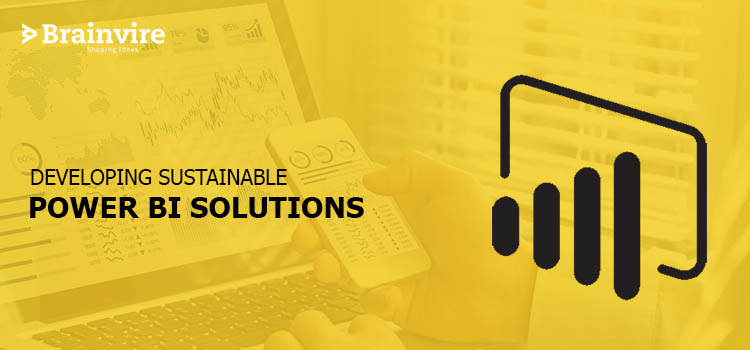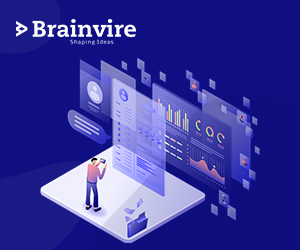
Data is the lifeblood of modern companies, and we’re producing it more than ever before.
But amassing tons of digital information is of no value unless organizations are able to make sense of it. This is where business intelligence software comes in.
In this article, we will dive deep into Microsoft’s flagship BI software named Power BI. We will look into the process of developing a Power BI solution.
The first aspect to consider when developing a Power BI solution is to review the logical architecture of your data visualization project. Power BI solutions have many moving parts and tools, especially when you look at the different data sources you can use. From local to web-based, public to private, you need to make sure you protect your data securely. With a good and clear architecture, you achieve not only a good but also a safe solution.
Architecture
Let’s take a brief overview of the various components of a logical architecture. The tabs are arranged by the number listed in the image. This architecture includes High-Level-Online-PowerBI.com (SaaS) and a local Power BI report server.
Actors / Staff
There are two groups of actors that can be classified in Power BI: developers and users.
Developers and Designers
The first group creates content in the form of data sets or visualizations. You are in the role of a developer and solution designer. They may not be working full time on the solution but will have a key role in the project.
You cannot create visualizations without data and a DBA. The data team needs to be involved not only in providing access to the data but also in creating data views.
The data should be ready for visualization and kept close to the data source. These are the main concerns regarding the data used in business analytics. Companies must leverage the power of the data servers while keeping in mind the investment that has gone into it. With 100 people using the same data for a report, a series of views will save you a lot of time, not only in development but also in reviewing the final result. In addition, 100 people cannot perform the same transformation and modification of data.
User Community
This group of people will be the end-users of the solution. There may be an overlap in some organizations, but this is broken down into the minimum necessary roles.
Admin / Audit / QA – End system support users including security, testing, and approval. It is the data owner or group assigned to ensure that the data in the final report is reconciled with the source system.
The role of the QA operator must include balancing and validating the calculations and formulas used in decision making. Audits should also be conducted proactively with balance sheets to capture breakthrough changes that may occur during the life of your project.
Analysts – These users have unique needs that set them apart, making their feedback and improvement suggestions exceptionally valuable. Early in the project, you can easily identify them as they are the primary consumers of your work. They utilize datasets produced in Power BI and possess the capability to craft their own dashboards and reports tailored to their specific solutions. As a trusted Microsoft partner, we prioritize delivering solutions that cater to the distinct requirements of such users and enhance their experiences.
End-User – This is just a report and dashboard user. Sometimes leadership teams have different needs from users and analysts. Such requirements include the ability to examine data in detail or to get proactive analysis and giving advice based on data. They are a source of managed analytics or stories built from data.
Data sources
Data sources in this architecture are divided into two groups:
- In cloud
- On-premise
Depending on your company policies, you may need to design your solution for working with data inside your firewalls.
Internet-based data sources – There can be in many forms-
- Structured data such as Azure databases
- Excel files on SharePoint or OneDrive
- Software as a Service (SaaS) such as Google Analytics
- Or simply websites that have been checked for data
On-premise data sources – These sources reside on your network. If you are using a Power BI report server, which is a server on your local network, you don’t have to worry about your data being stored in the cloud.
Security and Active Directory Access
Being able to retain the protection of your data and still use it in the cloud takes the same care as you do in your on-site data. Azure can be as reliable as your local data. The access to the Power BI SaaS and Power BI Report Server is managed by the Active Directory.
Azure Active Directory – This is the Active Directory (AD) cloud version, allowing for object security and identity management in a single location with unified policies and regulations. This represents the functionality offered by the AD on-site and you can use this to provide access to your Power BI reports and dashboards.
Active Directory Domain Services (On-premise)- Active Directory Domain Services is the basis for authentication and access to objects in your local network. It offers a wide range of hierarchical style identity and security-related services across users and groups.
Power BI Gateway
Power BI Gateway works with the dashboards generated using on-site data sources already deployed to PowerBI.com. It allows them to be modified either on a refresh schedule or on request by a data analyst. There are a few gateways depending on the solution you need. Power BI gateways are installed on a server or even a desktop computer on your local network. They provide outgoing data feeds to Power BI.
Power BI Reporting Server
This offers a combined on-site solution for self-service and business reporting. Power BI Report Server is a program installed on-site that is part of the Power BI Premium offering.
Power BI Service(SaaS)
This is a web-based Power BI service, which houses the data sets, reports, and dashboards you create using the Power BI Desktop. You can also schedule periodic dataset refreshes using the Refresh Schedule options.
Summing Up
In order to develop a good Power BI solution, all architectural elements of the solution need to be discussed. Getting a clear summary will make it easier to prevent issues later down the line.
Related Articles
-
Excel v/s Power BI- Time To Switch Your Reporting Practices
Modern businesses know the significance of data analysis and are trying to make the most of it. Research states that firms generate about 44 trillion GB data annually. With such
-
Benefits of Power BI: How Different Can Industries Use Power BI in 2023?
Currently, the market value of Power BI is about 4.48% with almost close to 10,000 companies already using it. Technologies such as the Internet of Things, Artificial Intelligence, and others
-
Power BI Consulting Services – MS Excel Power BI Data Types
The Progress of Excel There is no doubt that presently Excel has evolved to become the ultimate decision-making application. It allows to leverage the flexibility of the two-dimensional grid and



